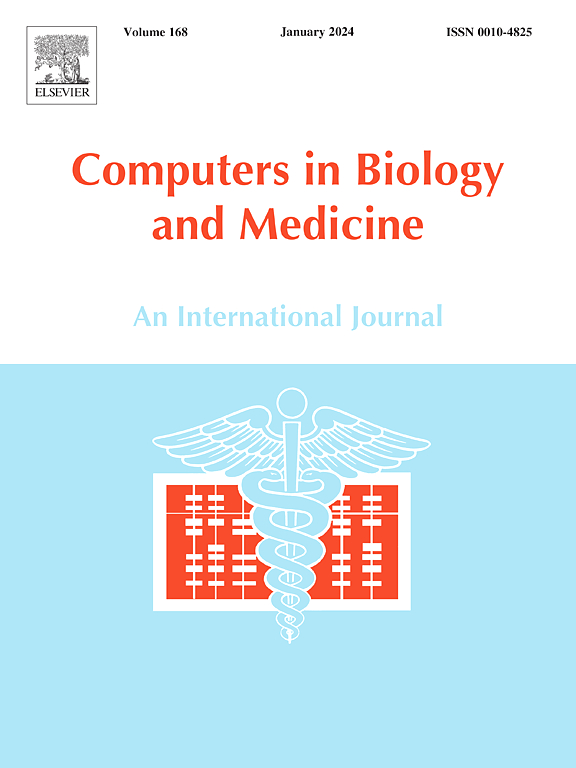基于动态图学习和解谜优化的关系双级聚合图卷积网络用于阿尔茨海默病分类
IF 7
2区 医学
Q1 BIOLOGY
引用次数: 0
摘要
阿尔茨海默病(AD)是一种以进行性认知能力下降为特征的神经退行性疾病,需要早期诊断才能有效治疗。本研究利用从阿尔茨海默病神经成像倡议(ADNI)存储库中收集的去噪t1加权磁共振图像(mri),提出了具有动态图学习和谜题优化的阿尔茨海默病分类关系双级聚合图卷积网络(RBAGCN-DGL-PO-AC)。针对医学成像中噪声的影响,该方法采用了改进样条核小波变换(MSKCT)、跳增积分递归神经网络(JGIRNN)和牛顿时间提取小波变换(NTEWT)等先进的去噪技术来提高图像质量。采用注意引导广义直觉模糊c均值聚类(AG-GIFCMC)对海马、侧脑室和后扣带皮层等对分类至关重要的脑区进行了分割。利用RBAGCN-DGL和谜题优化技术,利用分割输出进行特征提取和分类,将输入图像分为健康对照组(HC)、早期轻度认知障碍(EMCI)、晚期轻度认知障碍(LMCI)和阿尔茨海默病(AD)。为了评估所提出方法的有效性,我们通过广泛的消融研究系统地检查了RBAGCN-DGL-PO-AC模型的结构修改。实验结果表明,RBAGCN-DGL-PO-AC的准确率达到99.25%,优于现有的MSFFGCN_ADC、CNN_CAD_DBMRI和FCNN_ADC方法,训练时间减少28.5%,推理速度提高32.7%。因此,RBAGCN-DGL-PO-AC方法通过集成去噪、分割和基于动态图的特征提取来增强AD分类,达到了卓越的准确率,使其成为临床应用的宝贵工具,最终改善患者预后和疾病管理。本文章由计算机程序翻译,如有差异,请以英文原文为准。
Relational Bi-level aggregation graph convolutional network with dynamic graph learning and puzzle optimization for Alzheimer's classification
Alzheimer's disease (AD) is a neurodegenerative disorder characterized by a progressive cognitive decline, necessitating early diagnosis for effective treatment. This study presents the Relational Bi-level Aggregation Graph Convolutional Network with Dynamic Graph Learning and Puzzle Optimization for Alzheimer's Classification (RBAGCN-DGL-PO-AC), using denoised T1-weighted Magnetic Resonance Images (MRIs) collected from Alzheimer's Disease Neuroimaging Initiative (ADNI) repository. Addressing the impact of noise in medical imaging, the method employs advanced denoising techniques includes: the Modified Spline-Kernelled Chirplet Transform (MSKCT), Jump Gain Integral Recurrent Neural Network (JGIRNN), and Newton Time Extracting Wavelet Transform (NTEWT), to enhance the image quality. Key brain regions, crucial for classification such as hippocampal, lateral ventricle and posterior cingulate cortex are segmented using Attention Guided Generalized Intuitionistic Fuzzy C-Means Clustering (AG-GIFCMC). Feature extraction and classification using segmented outputs are performed with RBAGCN-DGL and puzzle optimization, categorize input images into Healthy Controls (HC), Early Mild Cognitive Impairment (EMCI), Late Mild Cognitive Impairment (LMCI), and Alzheimer's Disease (AD). To assess the effectiveness of the proposed method, we systematically examined the structural modifications to the RBAGCN-DGL-PO-AC model through extensive ablation studies. Experimental findings highlight that RBAGCN-DGL-PO-AC state-of-the art performance, with 99.25 % accuracy, outperforming existing methods including MSFFGCN_ADC, CNN_CAD_DBMRI, and FCNN_ADC, while reducing training time by 28.5 % and increasing inference speed by 32.7 %. Hence, the RBAGCN-DGL-PO-AC method enhances AD classification by integrating denoising, segmentation, and dynamic graph-based feature extraction, achieving superior accuracy and making it a valuable tool for clinical applications, ultimately improving patient outcomes and disease management.
求助全文
通过发布文献求助,成功后即可免费获取论文全文。
去求助
来源期刊

Computers in biology and medicine
工程技术-工程:生物医学
CiteScore
11.70
自引率
10.40%
发文量
1086
审稿时长
74 days
期刊介绍:
Computers in Biology and Medicine is an international forum for sharing groundbreaking advancements in the use of computers in bioscience and medicine. This journal serves as a medium for communicating essential research, instruction, ideas, and information regarding the rapidly evolving field of computer applications in these domains. By encouraging the exchange of knowledge, we aim to facilitate progress and innovation in the utilization of computers in biology and medicine.
 求助内容:
求助内容: 应助结果提醒方式:
应助结果提醒方式:


